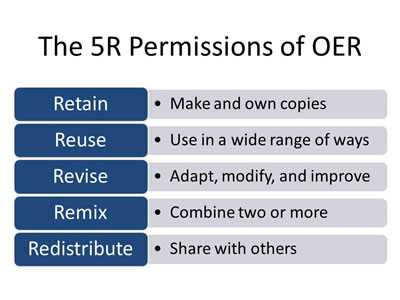What Are Open Educational Resources?
Open Educational Resources are teaching, learning, and research resources released under a license that permits their free use and repurposing by others. OERs can be full courses, course materials, lesson plans, open textbooks, learning objects, videos, games, tests, software, or any other tool, material, or technique that supports access to knowledge (SPARC). They are either in the public domain, or published with a Creative Commons license that legally enables users to freely engage in the "5 Rs":
- Retain - copy and own the resource (e.g., download a copy)
- Reuse - publicly use the resource (e.g., in a presentation or syllabus)
- Revise - adapt or modify the resource (e.g., translate it or update content)
- Remix - combine the resource with something new (e.g., adapt material for a podcast)
- Redistribute - share copies of the resource (original, or modified) with others (e.g., distribute as a class reading)
Open Educational Resources (OER) are "teaching, learning, and research resources that reside in the public domain or have been released under an intellectual property license that permits their free use and re-purposing by others" (The William and Flora Hewlett Foundation).

Head of Collections & Technical Services
Hugh & Hazel Darling Library #210
701 E. Foothill Blvd., PO Box 7000
Azusa, CA 91702
Why Do We Need Open Textbooks?
- Lower the cost of or free textbooks for students, making college more affordable
- Provide quicker access to materials.
- Are flexible and up-to-date.
Below is a graph showing the educational expensive for books and need for alternatives like OER.

OER Make an Impact

Type of Free Articles
If a resource is not free, or openly licensed, it is not an OER. For example, students can download a PDF of an article from the library - but journal and database subscriptions are not free-to-access, and may be cancelled if the library faces budget cuts. Even if materials are accessible, they do not inherently grant users permission to retain, reuse, revise, remix, or redistribute. As Abbey K. Elder shares in the OER Starter Kit, there are some fundamental differences between OERs, and materials commonly thought of as OERs:
| Material Type | Openly licensed | Free | Modifiable |
|---|---|---|---|
| Open Educational Resources | Yes | Yes | Yes |
| Free online resources, under "all rights reserved" copyright | No | Yes | No |
| Materials paid for by the library | No | Yes | No |
| Open Access articles and other resources | Yes | Yes | Maybe |
The 5R Open Course Design Framework
Open Educational Resources (OER) are free or low-cost educational materials that are in the public domain or have been made available with an open license. Creators and users are free to retain rights, reuse content, remix content, revise content, or redistribute content.
OER are typically digital, and can include but are not limited to textbooks, articles, journals, lectures, course packs, quizzes, streaming videos, tests, audio, or images. Most material is licensed under Creative Commons.

“5R Permissions of OER” by Lumen Learning “ https://lumenlearning.com/about/whats-oer/
